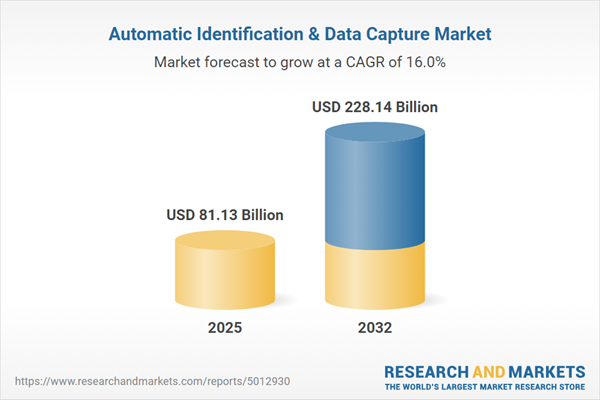Speak directly to the analyst to clarify any post sales queries you may have.
The automatic identification and data capture (AIDC) market is rapidly advancing as enterprises streamline critical operations, safeguard data integrity, and embrace intelligent automation across diverse sectors. Senior decision-makers seeking operational excellence now recognize AIDC as a core enabler of efficiency, accuracy, and digital transformation in modern workflows.
Market Snapshot: Growth Drivers in the Automatic Identification & Data Capture Market
The AIDC market grew from USD 69.75 billion in 2024 to USD 81.13 billion in 2025. Sustained by a compound annual growth rate (CAGR) of 15.96%, the sector is projected to reach USD 228.14 billion by 2032. This surge results from the growing adoption of barcode, RFID, biometric, and AI-powered identification technologies that empower organizations to minimize manual processes and leverage actionable data at scale.
Scope & Segmentation: Comprehensive Market Coverage
- Technology: Barcode systems (1D and 2D), biometric systems (facial, fingerprint, iris recognition), optical character recognition (printed and handwritten text), RFID (active, passive, semi-passive), and voice recognition (speaker dependent and independent)
- Application: Logical and physical access control, asset tracking for both fixed and portable assets, document management including archiving and imaging, inventory management, person identification, supply chain management (delivery, order, warehouse), time and attendance solutions (biometric and non-biometric)
- End Users: BFSI (banking, insurance), government and defense organizations, healthcare (clinics, hospitals, laboratories), manufacturing (automotive, electronics, food and beverage, pharmaceuticals), retail (apparel, ecommerce, grocery), transportation and logistics (freight forwarding, shipping, warehousing)
- Component: Hardware (accessories, readers and scanners, tags), services (consulting, implementation, maintenance and support), and software (asset management, data management, track and trace)
- Regions: Americas (United States, Canada, Mexico, Brazil, Argentina, Chile, Colombia, Peru), Europe, Middle East & Africa (UK, Germany, France, Russia, Italy, Spain, Netherlands, Sweden, Poland, Switzerland, UAE, Saudi Arabia, Qatar, Turkey, Israel, South Africa, Nigeria, Egypt, Kenya), Asia-Pacific (China, India, Japan, Australia, South Korea, Indonesia, Thailand, Malaysia, Singapore, Taiwan)
- Companies Analyzed: Zebra Technologies Corporation, Honeywell International Inc., Datalogic S.p.A., Cognex Corporation, Avery Dennison Corporation, SATO Holdings Corporation, TSC Auto ID Technology Co., Ltd., Impinj Inc., Checkpoint Systems Inc., Toshiba Tec Corporation
Key Takeaways for Senior Decision-Makers
- Integration of AIDC with enterprise systems and cloud platforms is critical, enabling near-instant data processing, real-time asset tracking, and advanced analytics for informed decisions.
- Convergence with IoT and machine learning allows organizations to automate data collection, implement predictive maintenance, and optimize end-to-end supply chain workflows.
- Adoption of AI-driven biometric identification, OCR, and voice recognition is expanding use cases into secure access, regulatory compliance, and hands-free manufacturing operations.
- Segment relevance varies by sector, with manufacturing, healthcare, and logistics accelerating investments in traceability, document automation, and resilient inventory management.
- Collaborative vendor partnerships and modular service offerings empower organizations to upgrade sensing and analytics capabilities efficiently and future-proof deployments.
Tariff Impact on Adoption and Supply Chains
New United States tariff measures implemented in 2025 are reshaping supply chain strategies for imported AIDC hardware and components. Organizations are mitigating cost pressures by exploring near-shoring, establishing local assembly, and strengthening logistics partnerships, thereby enhancing ecosystem resilience and safeguarding budgets amid evolving trade policy environments.
Methodology & Data Sources
This report employs a blend of primary and secondary research methods, including executive-level interviews, in-depth industry analysis, and triangulation of vendor white papers, regulatory documents, and logistics consultations. A vendor mapping framework supports rigorous, confidential data collection and integrity in all findings.
Why This Report Matters
- Provides actionable insight into segment-specific adoption trends and how advanced AIDC integrations can unlock operational efficiency across enterprise contexts.
- Delivers clear guidance on navigating regulatory, tariff, and digital transformation challenges while maximizing technology ROI in both established and emerging markets.
Conclusion
The automatic identification and data capture market is swiftly transforming as organizations prioritize intelligent automation, compliance, and strategic investment. This research delivers vital clarity for leaders shaping the future of operational excellence.
Additional Product Information:
- Purchase of this report includes 1 year online access with quarterly updates.
- This report can be updated on request. Please contact our Customer Experience team using the Ask a Question widget on our website.
Table of Contents
3. Executive Summary
4. Market Overview
7. Cumulative Impact of Artificial Intelligence 2025
Companies Mentioned
The companies profiled in this Automatic Identification & Data Capture market report include:- Zebra Technologies Corporation
- Honeywell International Inc.
- Datalogic S.p.A.
- Cognex Corporation
- Avery Dennison Corporation
- SATO Holdings Corporation
- TSC Auto ID Technology Co., Ltd.
- Impinj, Inc.
- Checkpoint Systems, Inc.
- Toshiba Tec Corporation
Table Information
| Report Attribute | Details |
|---|---|
| No. of Pages | 192 |
| Published | October 2025 |
| Forecast Period | 2025 - 2032 |
| Estimated Market Value ( USD | $ 81.13 Billion |
| Forecasted Market Value ( USD | $ 228.14 Billion |
| Compound Annual Growth Rate | 15.9% |
| Regions Covered | Global |
| No. of Companies Mentioned | 11 |









